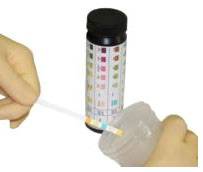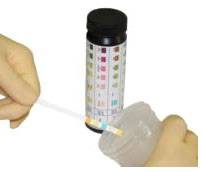Home » Home Health Care Products & Supplies » What is Diabetes? » What is Diabetes?
What is Diabetes?

Urine Reagent Strips for Glucose, Protein, pH, Blood and Ketone
Retail Price: $302.40
Your Price: $252.17
 Unit: 12/case
Unit: 12/case

Urine Reagent Strips Gl, Pr, PH, Blood, Ket, Bili, Nitr, Uro, and SG
Retail Price: $454.86
Your Price: $367.96
 Unit: 12/case
Unit: 12/case
What Is Diabetes?
More than 120 million people in the world and 16 million Americans have a form of Diabetes (Diabetes Mellitus). More than 5.4 million Americans are unaware they have Diabetes. Estimates place the dollar costs of Diabetes at $98 billion each year. Although the cause is still unknown, it is a metabolic disorder that is the sixth leading cause of death by disease in the U. S.
Diabetes is a condition or disorder that is characterized by the body's inability to correctly regulate blood sugar levels. This inability to regulate the transfer of glucose, which is blood sugar, in and out of the cells to provide adequate energy for the body is because of a decrease in the presence of insulin. Insulin is a hormone that is produced in the pancreas and released into the bloodstream based on the amount of glucose present in the blood. When the pancreas fails to produce enough or any insulin in response to elevated blood glucose levels the body cannot operate correctly and a variety of different potentially fatal conditions can occur. This is because the blood glucose, in the absence of correct levels of insulin, cannot be taken into the individual cells of the body.
Complications from diabetes may also include:
- Slow healing of wounds
- Poor circulation
- Nerve diseases
- Amputation of the feet
- Kidney disease and failure
- Vision changes--becoming more nearsighted
- Weak or leaking blood vessels in the retina (Diabetic Retinopathy)
- Blindness
- Heart disease
- Stroke
When the cells of the body do not have access to the fuel they need they cannot operate fully or they may cease to function entirely. The much needed blood glucose continues to rise in the body and is eliminated from the system in the urine. This is a condition known as hyperglycemia. This very highly elevated blood sugar level can impact many organs in the body including the kidneys, eyes, cardiovascular system, nervous system and even the skin. Extreme levels of blood sugar or reduced levels of blood sugar, known as hypoglycemia, can result in coma and death if not treated immediately.
History of Diabetes:
Diabetes is perhaps one of the earliest recognized health conditions largely because of the quantities of urine produced with the flushing of the unused glucose from the body and the characteristic sweet odor of the urine. It was an ancient Greek physician, Aretus the Cappadocian, who developed a formal recognition of the symptoms of the disease. Working in the second century A.D. he lacked the medical tests available today and instead based his diagnosis of the condition on observable symptoms. The term he chose to label the group of symptoms was diabainein, which is our word for siphon or pass through. The choice of terminology was due to the increased volume of urine production associated with the condition.
Mellitus, which was added in 1675 to the name diabetes, is a reference to the high sugar content of the urine. Mel is honey in Latin, and the researcher, Thomas Willis, added to second part of the name to recognize the elevated glucose levels found in all patients with the condition.
Diabetes Types:
There are three common or major categories or types of diabetes with different subcategories with regards to nomenclature. In essence the three most common types of diabetes are Type 1, Type 2 and Gestational Diabetes. There is also a fourth possible diagnosis and that is Prediabetes, which means that the individual has precursor symptoms that are typically associated with the development of Type 2 diabetes.
Type 1 diabetes is caused by a complete shut down in the pancreas with no production of insulin. People with Type 1 diabetes must take insulin in some form, generally injection, to control their blood sugar levels. In addition those with Type 1 diabetes have to carefully monitor their blood sugar levels to prevent the risks mentioned above. When Type 1 diabetes are diagnosed in children or young adults ages, 10-12 for girls and 12-14 for boys, it is also referred to as juvenile diabetes.
Type 2 diabetes is the most common type of diabetes, accounting for nearly 95 percent of diabetics. Type 2 diabetes occurs in adults, usually age 45 or older, whose bodies cannot make enough insulin or cannot correctly use their body’s insulin to convert sugars and starches into energy. Type 2 diabetes is caused by a decrease in the insulin production in the pancreas or a desensitization of the cells of the body to insulin. This type of diabetes can often be controlled by diet, exercise, lifestyle changes and tablet forms of insulin if required.
Gestational diabetes occurs during pregnancy and typically self-corrects once the baby is born. However women with a history of gestational diabetes have a higher rate of developing Type 2 diabetes later on in life.
Although every race and ethnic group is affected by Diabetes, Blacks, Hispanics and Native Americans, Asians and Pacific Islanders are more susceptible to Diabetes than other ethnic groups. Diabetes tends to run in families indicating both genetics and family environments are both involved.















